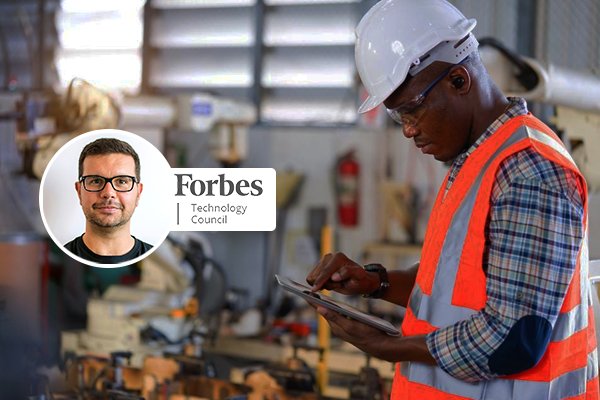Fabio Belloni – Chief Customer Officer and Co-founder of Quuppa and a leading authority on advanced location technologies discusses the role of Real-Time Location Systems In The Fourth Industrial Revolution.
The manufacturing and logistics industries have been a staple of the United States — and global — economy since the middle of the 19th century. A lot has changed and evolved since then.
Out of sheer necessity, this sector has long been a driver of innovation. Whether it was the movement from manual to steam-powered machinery during the initial Industrial Revolution, the widespread expansion of electricity during the Second Industrial Revolution or the third advancement with the internet and connectivity allowing for mass production and automation, these industries have continued to streamline their processes using the latest technologies available at the time.
Fast forward to 2021, which is ushering in the next wave of industrial innovation with the so-called era of “Industry 4.0.” While technologies such as artificial intelligence and the Internet of Things (IoT) have been earning headlines and rapidly developing in manufacturing and logistics, we’re witnessing the parallel advancement of industrial digitalization, out of which the maturation of a digital twin concept is greatly enabled thanks to the growing adoption of both location and context-aware technology enablers, such as real-time location systems (RTLS) and the Internet of Things. RTLS enables a wider range of location-based solutions that can improve operational safety and the entire manufacturing process from production and warehousing to delivery and even supply chain management.
“RTLS enables a wider range of location-based solutions that can improve operational safety and the entire manufacturing process from production and warehousing to delivery and even supply chain management.”
Fabio Belloni– Developer
My company was founded in the fall of 2012 by the team responsible for the invention of the High Accuracy Indoor Positioning (HAIP) at the Nokia Research Center. So, we have worked with IoT and RTLS since the early 2000s and have seen firsthand how this technology can be a huge benefit to many enterprises.
RTLS in safety and security increases operational efficiency and improves analytics.
Workers often operate side by side with machinery in industrial facilities. This results in the need for larger spaces, which in turn creates a myriad of potentially hazardous scenarios. Employers need to constantly be on the lookout for ways to make the work floors safer to prevent injuries, which is where RTLS comes in. More and more facility managers have turned to RTLS for help to fulfill security safety requirements, avoid collisions, improve evacuation efficiency, detect danger zones and monitor human vital signs.
Just like any other business, the goal for manufacturing and logistics companies is to generate profit. These companies are constantly striving to increase efficiency by implementing cutting-edge technologies to maximize their bottom lines. RTLS can solve many of these challenges, including maintenance process optimization, asset tracking, route optimization, inventory management and paperless orders.
Companies like UPS have been using IoT to monitor their fleets of trucks and drivers for years now to mine data and analytics and to improve processes. RTLS can be employed in much the same way. One of the biggest advantages of these digital solutions is the access they provide to data that was previously unavailable. And if there’s anything we know about 21st-century business, it’s that data is king. RTLS can help collect and store pertinent data by improving quality assurance, service-level-agreement (SLA) analytics and equipment-usage analytics.
What are the challenges to implementation?
There are several challenges to implementing an RTLS system in your organization, and the idea of moving forward can seem daunting, especially if you run multiple locations. One of the biggest obstacles with RTLS is — as with many aspects of business — getting leadership on board. It can be difficult to get company executives, owners, department managers and investors on the same page and willing to make a large operational change. However, once leadership is enthusiastic about a game plan, it will have a trickle-down effect to frontline staff, which will make adoption much easier.
With company leadership on the same page, the next step is to outline your goals for the RTLS system. There’s so much functionality with RTLS that some enterprises will focus on certain aspects more heavily than others. But, for the integration to be successful, it’s always best to be clear at the beginning regarding what a successful implementation will look like. A good place to begin is to examine and assess your current software systems.
One of the biggest factors to consider when implementing an RTLS system is scalability. Are there any upcoming mergers and acquisitions? Are you adding new facilities? Do you have additional expansion plans like, for example, using RTLS to power multiple use cases within the same facility? Organizations must look down the road and consider questions such as these when choosing the RTLS that best suit their needs. What fits perfectly today might not be as suitable two or more years in the future.
Of course, the big question that tends to be on everyone’s minds is in regards to reopening facilities in a post-pandemic economy. Hopefully, with the introduction of the vaccine and other protective measures, we can return to a sense of normalcy soon. However, we aren’t there yet, and another use case for RTLS is contact tracing to help reduce the workplace spread of Covid-19. The last thing any organization wants is an outbreak, and RTLS systems can help to isolate any cases that occur.
When you take a moment to look back, it’s fascinating how far the industry has come in such a short span. Just as steel and rails did way back when, technologies such as AI, IoT and RTLS serve as the sparks for today’s “Industry 4.0” revolution, with the manufacturing and logistics industry at the forefront once again.
“Just as steel and rails did way back when, technologies such as AI, IoT and RTLS serve as the sparks for today’s “Industry 4.0” revolution, with the manufacturing and logistics industry at the forefront once again.”
Fabio Belloni– Developer
When you take a moment to look back, it’s fascinating how far the industry has come in such a short span. Just as steel and rails did way back when, technologies such as AI, IoT and RTLS serve as the sparks for today’s “Industry 4.0” revolution, with the manufacturing and logistics industry at the forefront once again.
This article was first published here: Forbes.com

